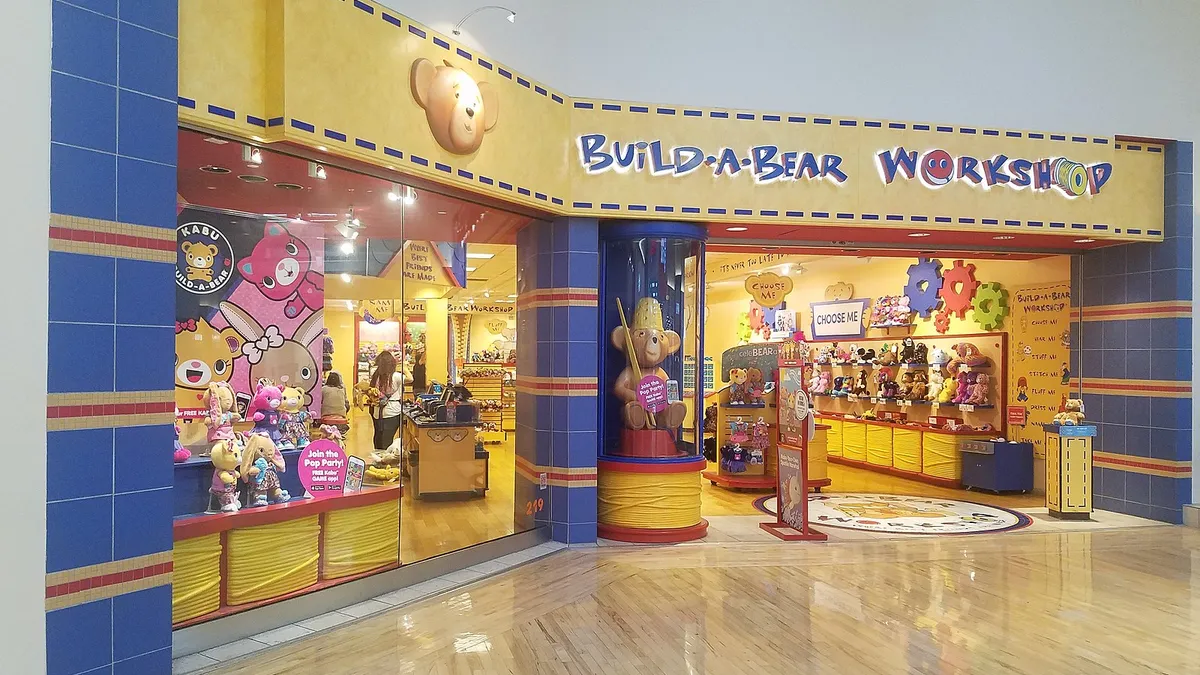Twenty-five-year-old Alyssa Karpinski estimates she owns between 150 and 160 Build-A-Bears. She has been collecting since she was little, and made her first bear with her dad.
“I remember everything about it,” she said. “I walked into my mom’s place of work at the time, and my mom goes, ‘Oh my God, you’ve just started something. And it’s not going to end.’”
Karpinski is not alone in her pursuit. She belongs to online groups and has an Instagram account dedicated to her collection of Build-A-Bears, Pokémon, Squishmallows and Jellycats with over 1,400 followers.
Part of Build-A-Bear’s success is that it produces items that evoke feelings of comfort for people, according to psychotherapist, toy analyst and researcher Peter Danzig. “It’s how it makes them feel. It brings up a set of emotions, or it’s a centering item … the playability is not so much as important as the experience,” they said.
While other specialty retailers are currently pointing to macroeconomics to explain falling sales, Build-A-Bear is reporting record-breaking numbers and a growing audience. After a stint of declining sales during the early part of the pandemic, the company is in the midst of a big turnaround. Last year was the most profitable year in Build-A-Bear’s history.
“Our record first half 2023 results follow our record-setting results for both 2021 and 2022, and demonstrate our ability to grow the Build-A-Bear brand at a sustainably higher level of profitability,” CEO Sharon Price John said on a call with analysts in late August.
The specialty toy company that helped define experiential retail in the late ‘90s has not only survived, but thrived. From inspiring viral moments, generating products that leverage pop culture IP and building a variety of store formats, everyone’s favorite cuddly retailer may be developing an empire.
There’s something about that cat
If you happen to be a Build-A-Bear collector, fall 2023 has been defined by one product in particular: Pumpkin Kitty. The plush cat, which retails for $35, is part of the retailer’s Vault Collection — a re-release of a design that made its debut in 2008.
But good luck getting your hands on one. The limited-edition item went viral, with collectors scrambling to find the plush toy and Build-A-Bear placing a limit of four per customer on the in-demand product. Pumpkin Kitty is now back in Build-A-Bear’s vault and no longer available. Many people have turned to purchasing one online, where it can run upwards of $300.
Going viral is, “something that any toymaker, any retailer would love to have happen,” James Zahn, editor-in-chief of The Toy Book, said in an interview. “Provided, of course, they go viral for a good reason.”
Many toy products have gone viral on social media platforms, and independent toy store owners are currently building massive followings on TikTok, said Zahn. Owners or staff will show off items that are new to their store to share in the excitement of a toy. That builds brand awareness for a particular product.
“If it happens for Build-A-Bear, they’re in the unique position that they’re the only one that’s selling it,” Zahn said about the retailer going viral. “So you have to come back to them in some way.”
And that means encountering Build-A-Bear products either online or in-stores — both arenas the company has spent time cultivating over the past few years.
The grown-ups are taking over
While some people may still associate Build-A-Bear as a store for kids, the company has a growing adult following.
The primary target for the company’s physical locations is families with children, but instead of growing by digitizing the Build-A-Bear in-store experience, the company instead wanted to extend the reach of its markets. That meant going after teens, adults, brand enthusiasts and collectors through its website and licensed relationships.
And it’s working. Teens and adults now generate around 40% of the company’s total sales.
The retailer redesigned its website last year with improved checkout, payment and product visualization features. It also has an age-gated online shop-in-shop focused on edgier products in “The Bear Cave,” and offers multiple options for gift giving, including romantic gifts.
Build-A-Bear also co-brands with a number of heavy hitting licenses including Star Wars, NBA, NFL, Marvel, DC Comics and Disney, among others.
“If there is a fandom that Build-A-Bear happens to cater to … and you’re into that — now they have something for you,” Zahn said. That includes costumes for the stuffed animals. “Essentially, you’ve got a teddy bear in cosplay.”
The right product at the right time
Even after 26 years in the business, Build-A-Bear may also have the exact right product at the exact right time for a public that is still reeling from the aftershock of a pandemic.
“Even before Build-A-Bear existed, the idea of the teddy bear, or comfort item, is something that most people really identify with,” Danzig said.
Within the toy industry, the plush market is currently doing well. The category is up 20% versus 2019, according to data from Circana. Total sales in 2022 for plush dolls reached $2.3 billion.
“The plush category has just been so huge the last couple of years,” Zahn said. “And it’s not really tapering off like the rest of the toy industry. Build-A-Bear was able to tap into that.”
During the pandemic there was a surge in nostalgia. Exploring, cleaning out and organizing homes meant that many people were longing for a simpler time, Danzig said.
“Those original audiences are now in their 40s and purchasing for their children,” they said regarding Build-A-Bear. “But, they also will maybe get one for themselves of their favorite character. You are seeing this kind of resurgence of acceptance and normality of having these play things around.”
Build-A-Bear dolls can also mark a particular place and time, thereby building a memory. Going to a store and creating a stuffed animal together has become a date night activity. For adult shoppers, the products are seen as home or holiday decor, or a way to mark an occasion, according to multiple experts.
Collector Karpinski has built a number of Pokémon bears with her boyfriend. “You can share the experience. I have a significant other that lives far away. I think it's cool that you can share the experience and their whole meaning behind it,” she said. “Since he lives so far away, it’s just nice to have something that reminds me of him.”
Danzig said that purchasing and playing with Build-A-Bear is marketed toward a very young audience. For shoppers outside of that age range, though, the appeal is “the presence of the object for comfort. It’s the experience of going into a retail store.”
The future (holiday) for bears
Building a plush animal at a traditional mall location is one path to obtaining a Build-A-Bear.
However, the retailer is exploring various methods for shoppers to find its products. The company has tourist locations, a Walmart model, a concourse model, seasonal locations, vending machines, event and temporary locations, a cruise ship model and a recently added format called Build-A-Bear Adventure, which includes an arcade and party rooms.
“You really have to put yourself where your consumer is. You have to meet them wherever they’re going to be. And they’ve been doing a good job at that,” Zahn said of Build-A-Bear.
Having a broad range of formats allows different physical locations to operate with less total square footage and higher productivity per square foot, according to the company.
Beyond being top of mind through a variety of location touchpoints, the company is also going to new spaces through its own intellectual property. This holiday season, Build-A-Bear released a movie, “Glisten and the Merry Mission,” in collaboration with Cinemark.
The film follows an elf named Marzipan who needs to believe in the magic of the season to save Christmas, and includes a lineup of notable voice talent including Dionne Warwick, Freddie Prinze Jr., Chevy Chase and Billy Ray Cyrus. The company has also released a set of plush characters based on the film.
“They’ve created this holiday property. It’s Christmasy, it’s wintery. They have the characters, they have the storytelling, and then — in turn — they are now going to have the products to go with it,” Zahn said. “So they’ve created what could be a franchise. Because if the movie performs well this year and becomes a perennial holiday favorite that families are going to watch over and over again until the end of time, they now have something that they can springboard into brand extensions, more filmed content, more animation. And of course, more toys.”
“It’s unique, because Build-A-Bear is a retailer, but they’re also a manufacturer and now they’re becoming an IP company,” Zahn added. “It’s really been a fascinating trajectory to watch.”






















